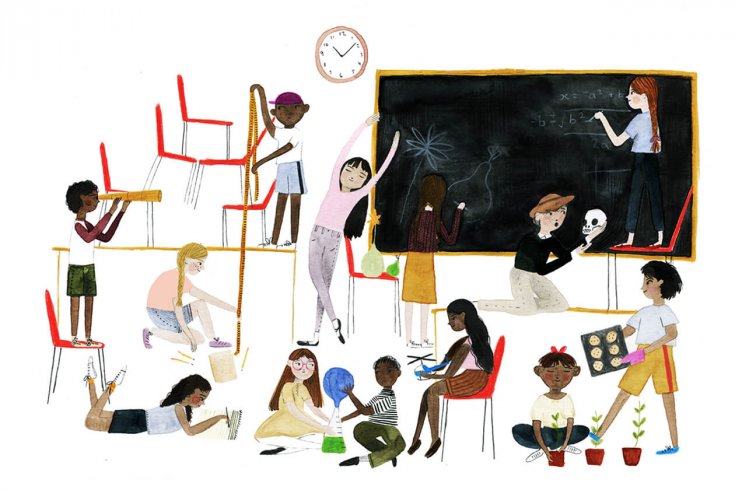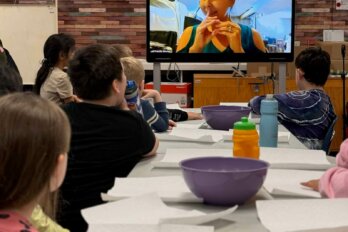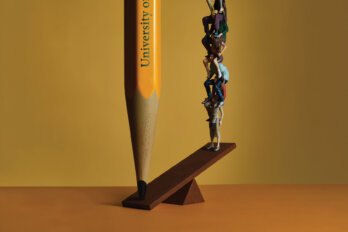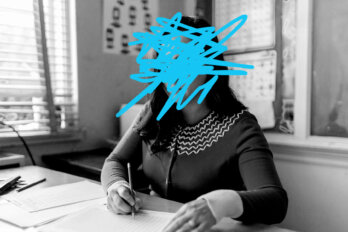At Douglas Park Elementary School in Regina, Saskatchewan, twelve-year-old Chloe wanted to learn about her ancestors.
She went online to find a genealogy website, but ran into various difficulties—some cost money, and others didn’t have the answers she sought. Undeterred, she tried a different strategy. She went to her grandparents’ house to interview them about their family his- tory, plotting their memories into a family tree of her own crafting.
In the very same Grade 7 class, Isaac—a boy who has always loved video games—decided to build one of his own with a friend. He already knew a bit of coding, but creating a video game would require him to master a new, more complex program. By the end of the term, he had developed a chase game where his characters jumped and leaped across a background of houses, trees, and a terrain that shifted as they moved.
Chloe and Isaac were self-taught, working on projects they themselves dreamed up. Behind their creative exploration was a teacher, Aaron Warner. Warner has built creativity into his classroom. “Genius Hour” is dedicated time for his students to pursue anything about which they are passionate, learning in their own way. It is loosely based on the model developed at Google, where software engineers were expected to spend up to 20 percent of their paid time working on their own ideas. “Twenty-percent time” projects led to the development of Gmail and Adsense, the advertising software that contributes approximately a quarter of the company’s vast revenue. Warner’s Genius Hour builds the same principle into the classroom, with students devoting two hours a week to their creative endeavours.
Warner learned about Genius Hour through his online professional learning community, comprised of educators from across the country and as far away as Australia. Every summer, Warner and his group read a book and discuss it on Twitter. Their first book was A.J. Juliani’s Innovation and Inquiry in the Classroom, which addresses what the media sometimes call a “creativity crisis.” It provides practical guidance to teachers trying to implement Genius Hour projects in their classrooms, from harnessing the support of other teachers, parents and students who think “this is awesome,” to reassuring those whose position is “this is great, but…”, to reaching out to those who think “this is crazy.”
As they engaged with the book, the teachers in the online community wrestled with various questions. If they encouraged students to do self-directed work, how would they assess it? Should students get a mark for following their passions? If they did not, how would they as teachers communicate students’ learning to their school leadership and to parents? The group discussed highlighting some of the skills built into, and exercised through, creative endeavours, like non-fiction writing and research skills, to demonstrate what their students were learning. As their summer of discussion came to a close, a group of teachers, including Warner, committed to adopting Genius Hour.
When he brought Genius Hour into the classroom, Warner had imagined that “magic would take place,” but when he invited students to do whatever they wanted, telling them “the sky’s the limit,” their first question was: “What do you want me to do?” Often, contemporary teaching emphasizes clear, measureable outcomes, detailed rubrics and step-by-step directions. The goal may be transparency, to break tasks down and to help students learn to self-assess, but often it can feel like students are being schooled in following instructions. In this context, it is a bit unsettling to be told: “You can do anything you want to.”
It was a pretty big hurdle. Warner went back to his Twitter community to ask for examples of what was happening in their classrooms. A high school science teacher shared a list of Genius Hour projects from his class that included understanding the circulatory system of a horse, how babies form inside the belly, how to build a small engine, how brain cancer spreads, how to improve hand–eye coordination, and what causes us to forget, as well as contemplating whether Big Foot exists (which included studying the history of the myth). That teacher confessed that not all of the ideas were particularly good ones, but he thought that having students learn that fact for themselves—experience failure and move on—was an important part of the hour.
The kids in Warner’s class came up with their own ideas—although at first they were not particularly ambitious. One student wanted to learn to serve a volleyball. Another wanted to learn how to make Rice Krispies squares. But with practice and encouragement over the course of the year, the kids started to think bigger. Some of the students were most enthusiastic about what they could teach each other, and how to make learning exciting. One student borrowed the school board’s projection tent to use as a mini-planetarium in order to teach her classmates about black holes.
The more they discovered their own potential, the more excited the students grew. And in year two, with a new group of students who had heard about the previous year’s class and had had a chance to wrap their heads around the idea, the start-up period was much shorter. It wasn’t just the kids who were paying attention. The other Grade 7/8 teacher incorporated Genius Hour into her classroom, and then the Grade 6/7 teachers tasked their students with developing self-directed “action plans” as a part of their health curriculum. Warner started working with teachers across the school division through a twice-yearly professional development “EdCamp,” where he supports them in bringing Genius Hour into their schools.
There is a sense of urgency around Warner’s innovative class-room projects. Genius Hour exercises skills often underused and undervalued in our education system: it allows students to stretch their imaginations, follow their own whims and curiosities, and define their own measures of achievement. It helps kids find different ways to succeed at an age when many are struggling with what success means. Genius Hour provides them with an opportunity to achieve outside the traditional borders of academia, and can actually bolster their confidence and engagement in the classroom.
The other reason Warner is committed to making space for creativity in the classroom is related to the larger world. Creativity is a vital life skill. It doesn’t just enrich day-to-day life; it is key to job-readiness in the broadest sense. As Warner notes, “Sixty percent of the jobs of the future haven’t been invented yet.”
This insight echoes Sir Ken Robinson’s argument, in the most-watched TED Talk of all time, titled “Do Schools Kill Creativity?”. Robinson made the case that creativity is central to developing education that will “take us into a future we can’t grasp.” Robinson believes that we must take seriously the fact that we cannot know what the world will look like. He is an advocate for school systems where creativity is considered as important as literacy and afforded the same status. There is an urgent need for original thinking to solve current and future problems—and original work will not happen unless children are prepared both to take risks and to put the tremendous talents with which they are born to use.
The standard definition of creativity is the generation of novel ideas or products. Creativity has also been defined as openness to exploration and as divergent thinking, which is the ability to generate numerous, diverse options or solutions. Creativity exists across traditional academic disciplines. While you can easily identify it in the fine arts, creativity is also a key aspect of domains as wide-ranging as business strategy, mathematical theory, and cooking.
Creativity is recognized as a critical “twenty-first century skill” by business groups, arts groups and international organizations like UNESCO and the Organisation for Economic Co-operation and Development (OECD). It is seen as essential to a rich and satisfying life, to the generation of new art and useful technologies, and to the solution of the world’s problems. Exercising creativity can also help to better prepare us emotionally for the unpredictable—training us to innovate and problem-solve on the fly, and strengthening our ability to take calculated risks.
Before becoming an international intellectual celebrity, Sir Ken Robinson chaired a national committee tasked with reviewing creativity and culture in British education. The resulting report, All Our Futures, wrestled with the challenges of trying to institutionalize creativity in the school system. Part of the challenge, the committee acknowledged, was achieving widespread recognition of creativity’s importance—another was determining how to actively change practices in schools. In an education environment dominated by test scores, boosting the status of creativity as one of schools’ core activities means working hard to challenge the primacy of measurable outcomes in the education system.
This process is not simple—it requires, for example, an approach to assessment that encourages students to make mistakes. You can’t “teach” creativity standing in front of a classroom, and “judging” a creative process or output is more complicated than marking a test. And there are differences in how people perceive creativity. To be creative, does something have to be completely original? In order to teach creativity, must schools mandate that their students produce a breakthrough in existing knowledge, or is a more permissive definition of creativity possible?
James Kaufman and Ronald Beghetto, cognitive psychologists who work at the University of Connecticut, are best known for developing a scale for creative acts, and in 2010 they co-edited Nurturing Creativity in the Classroom. Kaufman has been a leader in the study of creativity as a core aspect of psychology, and Beghetto has specialized in studying creativity in the classroom.
Their scale begins with what they call “mini-c creativity”: essentially, the pursuit of a creative project for personal enrichment. One step up is “little-c creativity,” which involves some mastery of a creative process. “Pro-c creativity” refers to creativity conducted on a professional level: graphic design; architecture; professional dancing, writing, or making a living as a musician. “Big-c creativity” is the stuff of legends: the discovery of the double helix, or the musical legacies of Mozart and the Beatles. Right now, schools mostly work in the range of mini-c and little-c creativity, although they can be given the tools to lay the groundwork for pro-c and even per- haps big-c creativity.
While almost all students enter high school thinking they will go on to post-secondary education, by the time they leave, aspirations are often quite different. Aiman Flahat, the principal of Toronto’s John Polanyi Collegiate Institute, understands that high expectations of students are critical, particularly in inner- city settings. A key means of implicitly communicating high expectations is by exposing students to the kinds of advanced skills that have been identified as being essential for future success—creativity among them.
John Polanyi Collegiate Institute, just northwest of downtown Toronto, first opened its doors in September 2011. Residents in Lawrence Heights, the surrounding neighbourhood, are predominantly first-generation immigrants from East and West African countries, the Caribbean and Latin America.
The community is also deeply affected by youth gangs and violent crime involving firearms. Another local principal expressed frustration about the neighbourhood’s bad reputation overshadowing the strengths of the community. But he acknowledged, “There are one or two major shootings in this area every year, and the impact on the students is enormous.” For Flahat, these circumstances are all the more reason to teach students “how to think and be able to solve big problems while maintaining a vision, being optimistic and not settling for the easy fixes.”
When Flahat became principal in January 2012, John Polanyi was under-subscribed, with only about three hundred students. Flahat was determined to attract students with aspirations of post-secondary studies—the best and the brightest from Lawrence Heights, the adjacent communities and beyond—and to become a centre of excellence in the sciences, mathematics, and robotics.
In one particularly striking commitment to raising expectations for its students, Flahat and his team forged a partnership with one of the world’s most highly regarded business schools, the Rotman School of Management at the University of Toronto. Former dean Roger Martin had developed a creative problem-solving methodology he calls “integrative thinking.” Martin had interviewed over fifty business leaders for his best-selling business book, The Opposable Mind: Winning Through Integrative Thinking. He profiled leaders like Michael Lee-Chin, the billionaire investor and philanthropist who grew up the child of store clerks in Jamaica, and Martin’s long-time client CEO Alan Lafley of Procter and Gamble.
The best thinkers, Martin argues, can hold two opposing ideas (or solutions) in their head at the same time, then synthesize to get the best of both. When Lafley started at Procter and Gamble, for example, he faced two competing strains of advice on how to manage the challenge of declining revenues. Some advocated cost-cutting and price wars with competing brands; others advocated investment in research and development. Lafley chose an approach that incorporated both methods, focusing on reorganization with an emphasis on reducing cost, and acquisition of smaller companies that were pioneering innovative products.
As the dean of a business school, Martin was convinced that higher education often trains students in analytical methods that actually work against the kind of creative synthesis he had seen to be a hallmark of successful business people. He sought to develop this skill in his students, teaching the approach to MBAs and commerce students. But he began to think, “Why are we waiting so long? Doing integrative thinking in business school is remedial. Let’s start teaching this before we have to ‘undo the damage’ of more conventional education.” His team decided to see if their program, called I-Think, had legs in the K–12 sector.
His team partnered with a handful of elite private schools, offering the program as an after-school extracurricular. The program spread to other private schools. As it gained buzz, the Toronto District School Board approached Rotman about bringing the program into public schools, especially those where students were facing significant challenges. One of those schools was John Polanyi.
Flahat helped incorporate the I-Think program into a Grade 12 business credit called Creative Problem Solving, and made sure the opportunity was available to all students. Rahim Essabhai, an experienced teacher in the school’s business department, worked with a research associate from Rotman to bring the course to life.
Essabhai is the “CEO” of his classroom, and his students work as consultants for the real-world clients with whom he pairs them. For example, he has connected his class with Rouge National Urban Park, in Scarborough, which wanted a team of students to advise them on their challenge of ensuring that urban youth use the park. He also paired them with Wounded Warriors, an organization that provides support to ill and injured veterans, which was interested in broadening its range of participants, and particularly in boosting the participation of women veterans.
Some years, Flahat gives the students a specific challenge that could serve to improve their school. He asked one class to try to use their creative problem-solving skills to build enrolment. They had already gone from three hundred students to seven hundred. What would it take to get to a thousand?
Sakaana Yasotharan was one of the Grade 12 students charged with increasing enrolment. Over the course of five weeks, Sakaana and her classmates used the integrative thinking methodology to wrestle with their problem. They identified two opposing models for boosting enrolment: offering niche appeal through specialized programs and becoming a community hub. Students needed to recognize—and live with—the competing strengths of the two models.
Sakaana’s group was more immediately drawn toward the community model because they saw how it responded to the needs of their neighbourhood. They worried the specialized school model was really about enticing students who weren’t like them. Sakaana remembers her group wondering, “What do kids from well-off families have that low-income students don’t?” and “Why should we want those kids here?”
The students had to condense all of their contemplation and discussion into two words that described the central strengths of each potential solution. Sakaana’s group chose mastery for the specialized school model, and the Swahili word ubuntu for the community hub model. They considered mastery to be a vital skill, and identified excelling at something as a valuable way to gain confidence; despite their initial suspicion of the specialized schools model, the students were eventually able to identify its assets, and what it could offer them. Ubuntu has been translated as, “I am who I am because we are who we are.” John Polanyi, they concluded, would increase its enrolment by supporting the development of both confidence and excellence (mastery) and a thriving, inclusive community (ubuntu).
At the end of the term, the I-Think students presented their work in the sleek, ultra-modern Rotman business school. One of the judges at the Rotman presentation was Roger Martin. He told the students that their presentation was one of the best he had seen, at any level of education.
Flahat was also inspired by his students’ ideas, and took their solutions seriously. Working with his staff, he pulled various strands from the students’ proposal and wove them into the life of the school. Sakaana’s group’s desire to incorporate the values of ubuntu aligned with his own vision for John Polanyi: “Creating a culture that is welcoming, and makes students feel empowered, rather than just getting things done, managing.”
The experience reflected Flahat’s belief that “when students are given an opportunity to make a difference—when they have real problems to solve that are connected and related to community and organizations—it ignites a passion for them to engage in their learning.”
As students became more engaged, they became more committed; and as they became more committed, they became more successful. The spirit of creativity fostered by the program spread throughout the school, and Flahat began to see his students succeeding in new and unexpected ways. They began winning prizes: SickKids’ MedTech Challenge for neurosurgical robotics; the University of Waterloo’s Pascal and Fermat Mathematics Contests; the Students for the Advancement of Global Entrepreneurship (sage) Canada National Entrepreneurial Competition, Social Enterprise Business category; and even archery competitions. Literacy scores rose. Math scores rose. And the school continues to break ground in its role as a community hub.
Excerpted from Pushing the Limits by Kelly Gallagher-Mackay and Nancy Steinhauer. Copyright © 2017 Kelly Gallagher-Mackay and Nancy Steinhauer. Published by Doubleday Canada, a division of Penguin Random House Canada Limited. Reproduced by arrangement with the Publisher. All rights reserved.
Nancy Steinhauer is an educational leader with over twenty years of experience and a recipient of Canada’s Outstanding Principals Award.




